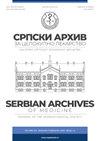不同脱矿液及不同暴露时间对人工初始龋形成的影响——体外研究
IF 0.2
4区 医学
Q4 MEDICINE, GENERAL & INTERNAL
引用次数: 0
摘要
介绍/目标。人工牙釉质龋齿通常用于模拟体内龋齿的发展,并研究非侵入性和微创方法在治疗初始龋齿病变中的效果。本研究的目的是比较三种不同的脱矿溶液和暴露时间对人工白斑病变形成的影响,并通过扫描电镜观察其脱矿效果。方法。20颗完整的人前磨牙,因正畸原因拔出,彻底清洁,室温下保存在0.1%百里酚溶液中,在牙髓-牙釉质交界处切割,然后进行脱矿处理。根据所使用的脱矿剂及暴露时间,将标本随机分为3个实验组:1组(醋酸;pH = 4.4;96小时);第二组(乳酸;pH = 4.5;120小时);第三组(乳酸;pH = 4.3;504小时)和1个对照组(生理盐水)。脱矿后检查肉眼外观,并在扫描电镜下观察所有标本的牙釉质特征和龋损深度。结果。ⅰ组和ⅱ组牙釉质表面下有孔隙,牙釉质晶体溶解,白斑病变平均深度分别为48.55 μ m (SD = 1.11)和43.23 μ m (SD = 6.74)。ⅲ组牙釉质表面结构完整性不完整。结论。实验1组和实验2组使用脱矿液,人工形成初始龋损,扫描电镜特征满意,外观相似。脱矿过程持续504小时,结果为牙釉质空化损伤。本文章由计算机程序翻译,如有差异,请以英文原文为准。
Effect of different demineralizing solutions and different exposing times on artificial initial caries lesion formation - an in vitro study
Introduction/Objective. Artificial enamel caries lesions are commonly created to simulate in vivo caries development and to examine the effect of non-invasive and microinvasive approaches in treatment of initial caries lesions. The objective of the present study was to compare three different demineralizing solutions and exposing times in terms of the formation of artificial white spot lesions and to evaluate their demineralization effect through Scanning Electron Microscopy observations. Methods. Twenty intact human premolars, extracted for orthodontic reasons, were thoroughly cleaned, stored in 0.1% thymol solution at room temperature and cut at the cementoenamel junction before demineralizing process. The specimens were randomly divided into three experimental groups, according to the used demineralization agent and the time of exposure: Group I (Acetic acid; pH = 4.4; 96 hours); Group II (Lactic acid; pH = 4.5; 120 hours); Group III (Lactic acid; pH = 4.3; 504 hours) and one control group (saline). After demineralisation, macroscopic appearance was checked and all specimens were observed under Scanning Electron Microscope to evaluate the enamel characteristics and caries lesion depths. Results. In Group I and II enamel subsurface porosity with dissolution of enamel crystals is detected and the mean depths of white spot lesions were 48.55 ?m (SD = 1.11) and 43.23 ?m (SD = 6.74), respectively. In Group III structural integrity of enamel surface was not preserved. Conclusion. Demineralizing solutions used in experimental groups I and II resulted in artificial initial caries lesions with satisfactory characteristics and similar appearance on Scanning Electron Microscopy. The outcome of demineralizing process which lasted 504 hours were cavitated enamel lesions.
求助全文
通过发布文献求助,成功后即可免费获取论文全文。
去求助
来源期刊

Srpski arhiv za celokupno lekarstvo
MEDICINE, GENERAL & INTERNAL-
CiteScore
0.40
自引率
50.00%
发文量
104
审稿时长
4-8 weeks
期刊介绍:
Srpski Arhiv Za Celokupno Lekarstvo (Serbian Archives of Medicine) is the Journal of the Serbian Medical Society, founded in 1872, which publishes articles by the members of the Serbian Medical Society, subscribers, as well as members of other associations of medical and related fields. The Journal publishes: original articles, communications, case reports, review articles, current topics, articles of history of medicine, articles for practitioners, articles related to the language of medicine, articles on medical ethics (clinical ethics, publication ethics, regulatory standards in medicine), congress and scientific meeting reports, professional news, book reviews, texts for "In memory of...", i.e. In memoriam and Promemoria columns, as well as comments and letters to the Editorial Board.
All manuscripts under consideration in the Serbian Archives of Medicine may not be offered or be under consideration for publication elsewhere. Articles must not have been published elsewhere (in part or in full).
 求助内容:
求助内容: 应助结果提醒方式:
应助结果提醒方式:


